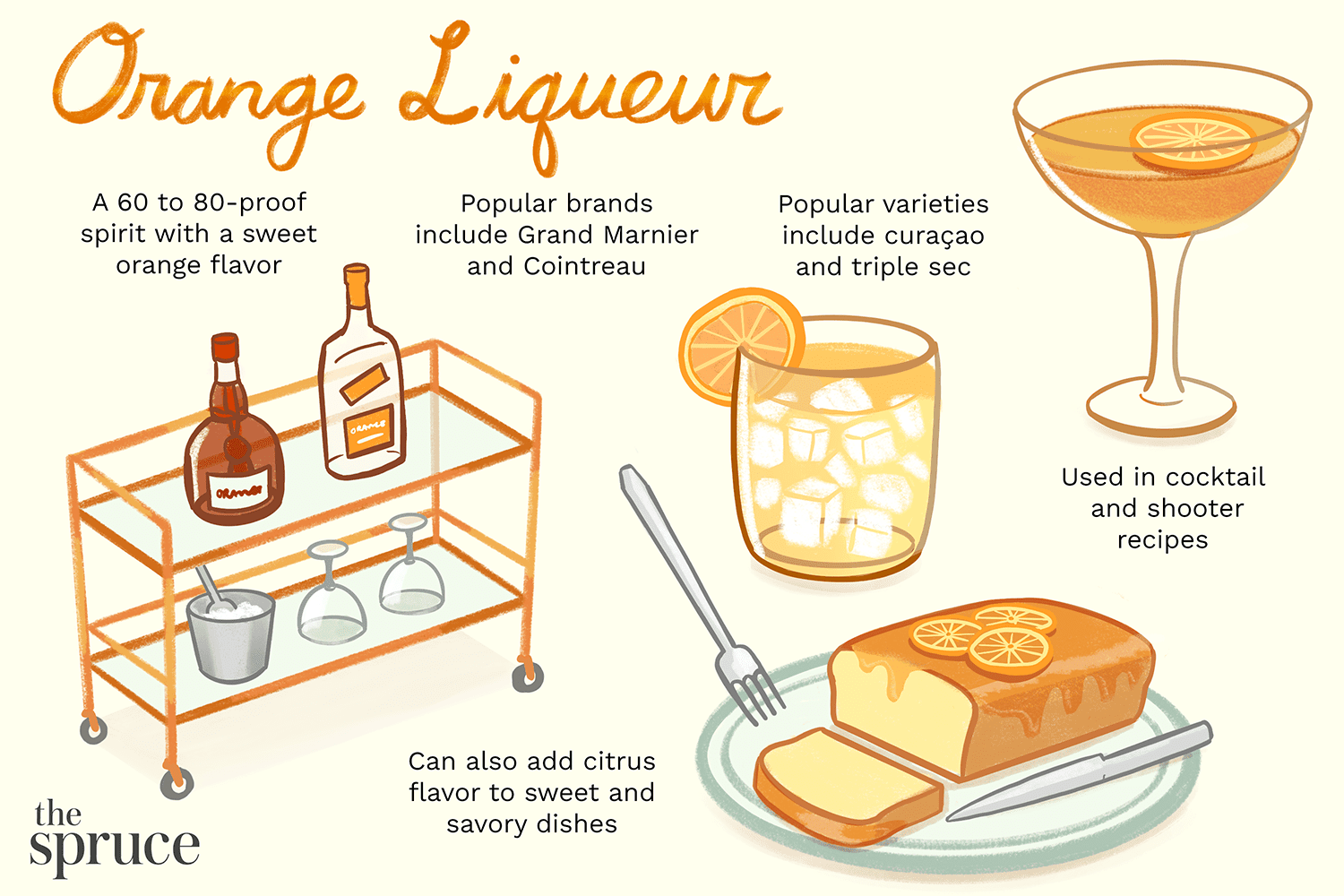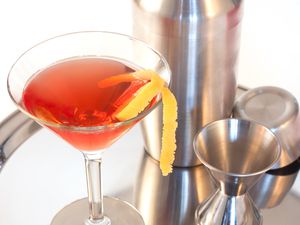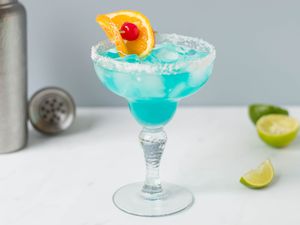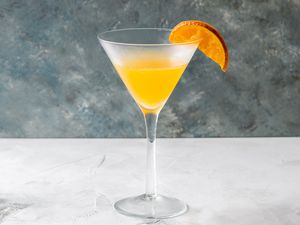
Orange liqueurs are a diverse group of distilled spirits flavored with the citrus fruit. Most are sweet and some use a neutral grain base while others feature a liquor such as brandy. There are many orange liqueurs available and they're produced worldwide, including in the Caribbean, Netherlands, France, and Italy. You will see the names triple sec, curaçao, Cointreau, and Grand Marnier in cocktail recipes, though some simply list orange liqueur as an ingredient. Of all of the liqueurs on the market, orange liqueurs are used most often and that makes them essential for a well-stocked bar.
Fast Facts
- Ingredients: Orange
- Proof: 60–80
- ABV: 30–40%
- Origin: Caribbean, Netherlands, France, Italy, Mexico
- Taste: Sweet, citrusy, orange
- Serve: Cocktails, shots
What Is Orange Liqueur Made From?
Orange liqueur is a sweetened distilled spirit that is flavored with oranges. The production methods used vary by brand and style. Orange liqueurs may use a base that is a neutral grain spirit (similar to vodka), rum, or brandy. The orange flavor often comes from dried orange peels or orange essential oil, though that's not always the case. They generally range from 30 percent alcohol by volume (ABV, 60 proof) to 40 percent ABV (80 proof).
There are three basic types of orange liqueurs: curaçao, triple sec, and brandy-based. There are also brands that fall into none of those categories. These may feature a particular variety of oranges, be a bitter (rather than sweet) liqueur, or include additional ingredients such as herbs, spices, or artificial flavors. Some, for the pure purpose of branding, do not use a particular category on the label.
What Does Orange Liqueur Taste Like?
Orange liqueurs have a signature taste of oranges. They tend to be very sweet, some almost syrupy, though some can have a drier mouthfeel.
Types
- Curaçao: Curaçao (pronounced kurra-sow, also curaçoa) liqueur is the oldest style of orange liqueur and originated on the Caribbean island of the same name. It is believed that when the Spanish planted orange trees there, the climate produced a bitter fruit that was better after drying. Eventually, the dried peels of small laraha oranges were used to flavor the liquor. The Dutch company Bols claims to be the first to produce curaçao. It is often called for in classic cocktail recipes. Around the turn of the 20th century, curaçao producers began selling it in a variety of colors: orange, white (clear), blue, and (rarely) green. The orange and white liqueurs are the most versatile; blue curaçao is one of the most common ways to create blue cocktails. Most curacao is 60 proof.
Tip
Blue curaçao is also available in a nonalcoholic form that is actually a syrup. This is useful when you want to turn mocktails a shade of blue. It can often be found in the mixer section of the liquor store next to the grenadine, sodas, and lime juice.
- Triple Sec: Triple sec is the French answer to Dutch curaçao. Both Cointreau (pronounced kwahn-troh) and Combier have claimed to be the first triple sec. Sec means "dry" in French and triple sec is often thought to mean "triple dry," though it can refer to a triple-distilled liqueur. There's also a claim that the name refers to the third attempt at Cointreau's recipe (the one still in use). Today, "triple sec" is more of a generic term for an orange liqueur and there are many brands that vary greatly in quality, flavor, and sweetness. Cointreau and Combier are the most trusted premium brands available; many are considerably lower in quality, typically not palatable on their own. This liqueur is often clear, though some with a brandy base may have a golden color. Most triple sec is 60 proof; Cointreau and Combier Original are 80 proof.
- Brandy-Based: Many of the original curaçaos had either a brandy or rum base and a few orange liqueurs continue to use brandy or Cognac. The French liqueur, Grand Marnier, is the best known and was originally called "Curaçao Marnier." It uses Cognac, is often preferred by bartenders, and can be drunk on its own. Its Italian counterpart, Gran Gala has a brandy base and is comparable in quality. Both liqueurs are 80 proof.
- O3: One of the liqueurs in the product line of DeKuyper, O3 is a premium orange liqueur that can be used in a variety of cocktails. It is flavored with the essential oils of the Brazilian pera orange and bottled at 80 proof.
- Patrón Citrónge: Produced by Patrón Tequila, Citrónge (80 proof) has a base of neutral grain spirits and is flavored with organic Jamaican and bittersweet Haitian oranges. It's a good option for margaritas and other tequila cocktails.
- Solerno Blood Orange Liqueur: Produced in Sicily, Solerno (80 proof) is a premium liqueur with a deep, darker orange flavor. It has a neutral spirit base and goes through three rounds of distillation: one with whole Sanguinello blood oranges, one with blood orange peel, and one with Sicilian lemons.
- Borducan Orange Liqueur: This orange liqueur is often compared to Cointreau, though it's not a triple sec. It is less sweet but with a bolder orange flavor accented with Alpine herbs and saffron. Borducan is produced in northern Italy, has a neutral spirit base, and is bottled at 70 proof.
- Aperol: This aperitif has a bright orange flavor and color. It is not sweet, but bitter. Aperol is produced in Italy and is infused with bitter and sweet oranges along with a proprietary recipe of herbs and roots. It mixes very well in simple, high-end cocktails, including the signature Aperol Spritz and is bottled at 22 proof.

How to Drink Orange Liqueur
For the most part, orange liqueurs are not enjoyed on their own. Brandy-based liqueurs like Grand Marnier are the exception and nice when served on the rocks or topped with light soda. Beyond that, they're generally reserved for cocktails and shooters. Orange liqueurs are found in a variety of cocktail recipes, including sours, martinis, and highballs, as well as blended and hot drinks. They're common in shot recipes and often prized for their color and sweet taste in layered shooters.
It can be difficult to know which style to use in different drinks. Some cocktails work best with the darker Grand Marnier while others are better with the crispness of a premium curaçao or triple sec. Many recipes will suggest a particular orange liqueur or brand. Others use the generic name of triple sec or curaçao.
When choosing the orange liqueur to use, consider these tips:
- Keep both a light and a dark orange liqueur in the bar. The most common premium choices are Cointreau (light) and Grand Marnier (dark), though there are other brands that are equal in quality to both.
- When substituting, try to retain that same light or dark base that the recipe calls for.
- A cheap orange liqueur (especially triple secs and curaçaos) can ruin an otherwise perfect cocktail.
- If you have a favorite orange liqueur and a new recipe that calls for a different liqueur, give your favorite a try. It is likely to be just as good, if not more pleasing to you.
- When left with no other guide than "orange liqueur," follow the theory of pairing light liqueurs with light cocktails and dark with dark. For instance, in gin, rum, and tequila cocktails, you might begin with a curaçao while in cocktails with brandy or whiskey, Grand Marnier may be a good place to start.
Cocktail Recipes
The list of popular cocktails that feature an orange liqueur of some type is long. It's found in classic recipes as well as modern creations, but a few are essential to a well-rounded cocktail experience:
Popular Brands
The orange liqueur market is diverse. Some brands specialize in a single orange liqueur or style. Others produce a variety of flavored liqueurs, sometimes offering both triple sec and curaçao within their portfolio.
- Aperol
- Bols
- Cointreau
- DeKuyper
- Grand Marnier
- Hiram Walker
- Patrón Citrónge
- Senior Curaçao of Curaçao
Cooking With Orange Liqueur
Orange liqueurs can also be found in food recipes. You might find one used to add a sweet citrus flavor to cakes, create syrups for fruits, or incorporated into a marinade or glaze for meats.














